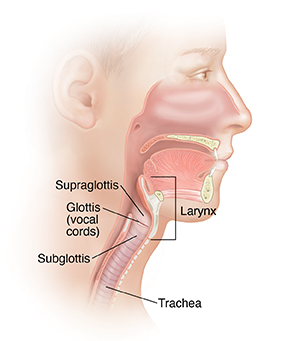What is cancer?
Cancer starts when cells in the body change and grow out of control. To help you understand what happens when you have cancer, let's look at how your body works normally. Your body is made up of tiny building blocks called cells. Normal cells grow when your body needs them and die when your body doesn't need them any longer.
Cancer is made up of abnormal cells that grow even though your body doesn't need them. In most cancers, the abnormal cells grow to form a lump or mass called a tumor. If cancer cells are in the body long enough, they can grow into (invade) nearby areas. They can even spread to other parts of the body (metastasis).
What is laryngeal cancer?
Laryngeal cancer starts when normal cells change and grow out of control. These cells form a cancer tumor in the larynx (voice box), which is in your neck. Cancer can start in any part of the larynx.
About the larynx
The larynx is about 2 inches long and looks like a tube. You use your larynx to breathe, talk, and swallow.
The larynx is at the top of the windpipe or trachea. Its walls are made mainly of a stiff tissue called cartilage. The thyroid cartilage in the front of the larynx is called the Adam’s apple.
The larynx has 3 main parts:
-
Glottis. This is the middle section where the vocal cords are.
-
Supraglottis. This is above the vocal cords.
-
Subglottis. This is below the vocal cords. It's where the larynx connects to the trachea.
When you breathe in, air travels through your larynx, down your trachea, and into your lungs. The air travels the other way when you breathe out. The vocal cords are relaxed when you breathe, and air moves between them without making any sound. When you talk, the vocal cords tighten up and move closer together. Air from your lungs is forced between them and causes them to vibrate, making sound. Your tongue, lips, and teeth turn this sound into words.
Just behind the trachea and the larynx is the food pipe or esophagus. This is a soft, collapsible tube that carries food from your mouth to your stomach. The openings of the esophagus and larynx are very close to each other. A flap called the epiglottis covers the larynx to keep food from going down the wrong tube when you swallow.
How laryngeal cancer spreads
If cancer cells spread outside the larynx, they tend to first go to the lymph nodes, or lymph glands, in the neck. Cancer cells can also spread to the back of the tongue, other parts of the throat and neck, and even other parts of the body, like the lungs and the spine.
When cancer cells from the larynx spread to distant parts of the body, it's called metastatic laryngeal cancer.
Talk with your healthcare provider
If you have questions about laryngeal cancer, talk with your healthcare provider. Your healthcare provider can help you understand more about this cancer.
Featured in


